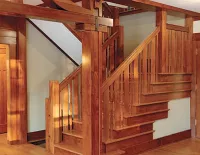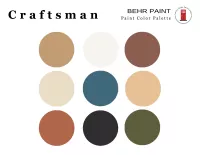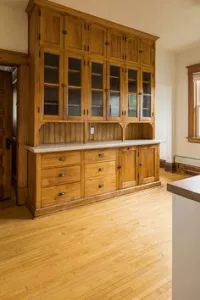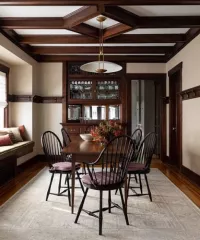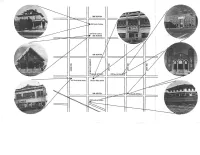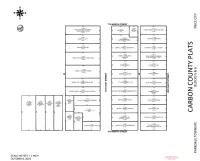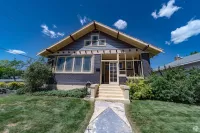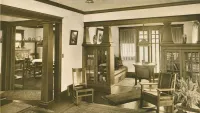Share what you know,
and discover more.
Share what you know,
and discover more.
Nov 08, 2024
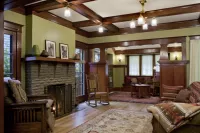
-

- Marley Zielike
Craftsman Interior Design
Craftsman architecture, a hallmark of the early 20th century, emerged from the Arts and Crafts Movement, which emphasized the value of handcraftsmanship and simple, honest design in response to the Industrial Revolution's mass production. Influenced by the work of designers like Gustav Stickley and the architectural legacy of the Greene brothers (Charles and Henry Greene), Craftsman homes prioritize craftsmanship, natural materials, and a harmonious integration of indoor and outdoor spaces. Key Features of Craftsman Interior Design Open Floor Plans with Defined Spaces Craftsman interiors typically feature open yet subtly defined spaces. For example, living and dining areas are often open to each other but separated by built-in bookcases or wood columns. This layout was designed to facilitate social gatherings and emphasize the functional and communal nature of the home. Rich Woodwork and Natural Materials The use of natural wood is a defining characteristic of Craftsman homes. Oak, mahogany, or fir is often used for built-in furniture, exposed beams, wainscoting, crown moldings, and trim around windows and doors. The woodwork is typically stained to highlight the natural grain, adding warmth and depth to the interiors. The emphasis on natural materials extends to stone fireplaces, tilework, and even flooring, often featuring hardwood or slate. Built-In Furniture Functional and handcrafted built-ins are an essential feature of Craftsman interior design. These include bookcases flanking the fireplace, window seats, dining room buffets, and even integrated writing desks or sideboards. Built-ins provide practicality while also showcasing the beauty and craftsmanship of the home's woodwork. Earthy Color Palettes Craftsman interiors embrace earthy and nature-inspired colors, such as warm browns, deep greens, rusts, and soft golds. These colors reflect the organic tones found in the surrounding landscape and contribute to the overall warmth and coziness of the home. Wall finishes may include painted plaster or simple, neutral wallpapers with nature-inspired patterns. Handcrafted Details and Hardware The focus on handcrafted quality extends to smaller details, including the hardware and light fixtures. Craftsman homes often feature metalwork in oil-rubbed bronze, hammered copper, or wrought iron. Light fixtures, often in the form of lanterns or pendant lights, are simple yet striking, sometimes adorned with art glass shades to diffuse the light softly. Fireplaces as a Focal Point The fireplace is often the centerpiece of the Craftsman living room. It is typically flanked by built-in bookcases or benches and constructed with natural materials like stone or brick. The mantle is often made of rich wood, and the design may include decorative tile work that complements the home’s color palette. The surrounding area is intentionally inviting, serving as a gathering space for the family. Leadlight and Stained Glass Craftsman interiors frequently include stained or leaded glass windows. These can be found in cabinets, entry doors, or transom windows, often showcasing simple geometric patterns inspired by nature, such as leaves, flowers, or tree branches. The use of stained glass adds a touch of artistry and color, emphasizing the movement's dedication to handcrafted detail. Simple, Elegant Textiles Textiles in Craftsman homes are kept simple to complement the clean lines of the architecture. Curtains, rugs, and upholstery are made from natural fibers like wool, linen, or cotton, often featuring geometric patterns or designs inspired by nature. These textiles are functional, durable, and add warmth to the space without overpowering the architectural elements. Mission-Style and Stickley Furniture Furniture in a Craftsman home is designed to be both beautiful and functional, embodying the ethos of the Arts and Crafts Movement. Mission-style furniture, often designed by Gustav Stickley, is characterized by clean, straight lines, flat panels, and visible joinery. Pieces are typically made of oak and upholstered with leather or simple fabrics. This furniture style enhances the authenticity and timeless appeal of Craftsman interiors. Emphasis on Artistry and Practicality Craftsman interior design balances beauty with function. Decorative elements are thoughtfully placed, and ornamentation is minimal, focusing on craftsmanship and the integrity of the materials. The overall effect is a space that feels both artful and practical, perfect for comfortable, everyday living. Legacy of Craftsman Interiors The enduring appeal of Craftsman interiors lies in their emphasis on quality, authenticity, and a strong connection to nature. Even today, Craftsman homes are admired for their timeless warmth and the way they celebrate handcrafted beauty. The interiors remain a testament to the idea that a home should be a welcoming, functional, and artful space, built to withstand the test of time. Photo 1: An example of an open-concept layout with a defined space at the back of the room. Photo 2: Woodwork, a hallmark of Craftsman homes, with the staircase showcasing Mission-Style design. Photo 3: A modern Craftsman color palette. Photo 4: A built-in cabinet featured in a Craftsman-style kitchen. Photo 5: Stylish furniture complementing a Craftsman interior. Photo 6: Leaded glass details that add a touch of elegance.
Craftsman Interior Design
Craftsman architecture, a hallmark of the early 20th century, emerged from the Arts and Crafts Movement, which emphasized the value of handcraftsmanship and simple, honest design in response to the Industrial Revolution's mass production. Influenced by the work of designers like Gustav Stickley and the architectural legacy of the Greene brothers (Charles and Henry Greene), Craftsman homes prioritize craftsmanship, natural materials, and a harmonious integration of indoor and outdoor spaces. Key Features of Craftsman Interior Design Open Floor Plans with Defined Spaces Craftsman interiors typically feature open yet subtly defined spaces. For example, living and dining areas are often open to each other but separated by built-in bookcases or wood columns. This layout was designed to facilitate social gatherings and emphasize the functional and communal nature of the home. Rich Woodwork and Natural Materials The use of natural wood is a defining characteristic of Craftsman homes. Oak, mahogany, or fir is often used for built-in furniture, exposed beams, wainscoting, crown moldings, and trim around windows and doors. The woodwork is typically stained to highlight the natural grain, adding warmth and depth to the interiors. The emphasis on natural materials extends to stone fireplaces, tilework, and even flooring, often featuring hardwood or slate. Built-In Furniture Functional and handcrafted built-ins are an essential feature of Craftsman interior design. These include bookcases flanking the fireplace, window seats, dining room buffets, and even integrated writing desks or sideboards. Built-ins provide practicality while also showcasing the beauty and craftsmanship of the home's woodwork. Earthy Color Palettes Craftsman interiors embrace earthy and nature-inspired colors, such as warm browns, deep greens, rusts, and soft golds. These colors reflect the organic tones found in the surrounding landscape and contribute to the overall warmth and coziness of the home. Wall finishes may include painted plaster or simple, neutral wallpapers with nature-inspired patterns. Handcrafted Details and Hardware The focus on handcrafted quality extends to smaller details, including the hardware and light fixtures. Craftsman homes often feature metalwork in oil-rubbed bronze, hammered copper, or wrought iron. Light fixtures, often in the form of lanterns or pendant lights, are simple yet striking, sometimes adorned with art glass shades to diffuse the light softly. Fireplaces as a Focal Point The fireplace is often the centerpiece of the Craftsman living room. It is typically flanked by built-in bookcases or benches and constructed with natural materials like stone or brick. The mantle is often made of rich wood, and the design may include decorative tile work that complements the home’s color palette. The surrounding area is intentionally inviting, serving as a gathering space for the family. Leadlight and Stained Glass Craftsman interiors frequently include stained or leaded glass windows. These can be found in cabinets, entry doors, or transom windows, often showcasing simple geometric patterns inspired by nature, such as leaves, flowers, or tree branches. The use of stained glass adds a touch of artistry and color, emphasizing the movement's dedication to handcrafted detail. Simple, Elegant Textiles Textiles in Craftsman homes are kept simple to complement the clean lines of the architecture. Curtains, rugs, and upholstery are made from natural fibers like wool, linen, or cotton, often featuring geometric patterns or designs inspired by nature. These textiles are functional, durable, and add warmth to the space without overpowering the architectural elements. Mission-Style and Stickley Furniture Furniture in a Craftsman home is designed to be both beautiful and functional, embodying the ethos of the Arts and Crafts Movement. Mission-style furniture, often designed by Gustav Stickley, is characterized by clean, straight lines, flat panels, and visible joinery. Pieces are typically made of oak and upholstered with leather or simple fabrics. This furniture style enhances the authenticity and timeless appeal of Craftsman interiors. Emphasis on Artistry and Practicality Craftsman interior design balances beauty with function. Decorative elements are thoughtfully placed, and ornamentation is minimal, focusing on craftsmanship and the integrity of the materials. The overall effect is a space that feels both artful and practical, perfect for comfortable, everyday living. Legacy of Craftsman Interiors The enduring appeal of Craftsman interiors lies in their emphasis on quality, authenticity, and a strong connection to nature. Even today, Craftsman homes are admired for their timeless warmth and the way they celebrate handcrafted beauty. The interiors remain a testament to the idea that a home should be a welcoming, functional, and artful space, built to withstand the test of time. Photo 1: An example of an open-concept layout with a defined space at the back of the room. Photo 2: Woodwork, a hallmark of Craftsman homes, with the staircase showcasing Mission-Style design. Photo 3: A modern Craftsman color palette. Photo 4: A built-in cabinet featured in a Craftsman-style kitchen. Photo 5: Stylish furniture complementing a Craftsman interior. Photo 6: Leaded glass details that add a touch of elegance.
Nov 08, 2024
Craftsman Interior Design
Craftsman architecture, a hallmark of the early 20th century, emerged from the Arts and Crafts Movement, which emphasized the value of handcraftsmanship and simple, honest design in response to the Industrial Revolution's mass production. Influenced by the work of designers like Gustav Stickley and the architectural legacy of the Greene brothers (Charles and Henry Greene), Craftsman homes prioritize craftsmanship, natural materials, and a harmonious integration of indoor and outdoor spaces.Key Features of Craftsman Interior Design
Open Floor Plans with Defined Spaces Craftsman interiors typically feature open yet subtly defined spaces. For example, living and dining areas are often open to each other but separated by built-in bookcases or wood columns. This layout was designed to facilitate social gatherings and emphasize the functional and communal nature of the home.
Rich Woodwork and Natural Materials
The use of natural wood is a defining characteristic of Craftsman homes. Oak, mahogany, or fir is often used for built-in furniture, exposed beams, wainscoting, crown moldings, and trim around windows and doors. The woodwork is typically stained to highlight the natural grain, adding warmth and depth to the interiors. The emphasis on natural materials extends to stone fireplaces, tilework, and even flooring, often featuring hardwood or slate.
Built-In Furniture Functional and handcrafted built-ins are an essential feature of Craftsman interior design. These include bookcases flanking the fireplace, window seats, dining room buffets, and even integrated writing desks or sideboards. Built-ins provide practicality while also showcasing the beauty and craftsmanship of the home's woodwork.
Earthy Color Palettes Craftsman interiors embrace earthy and nature-inspired colors, such as warm browns, deep greens, rusts, and soft golds. These colors reflect the organic tones found in the surrounding landscape and contribute to the overall warmth and coziness of the home. Wall finishes may include painted plaster or simple, neutral wallpapers with nature-inspired patterns.
Handcrafted Details and Hardware
The focus on handcrafted quality extends to smaller details, including the hardware and light fixtures. Craftsman homes often feature metalwork in oil-rubbed bronze, hammered copper, or wrought iron. Light fixtures, often in the form of lanterns or pendant lights, are simple yet striking, sometimes adorned with art glass shades to diffuse the light softly.
Fireplaces as a Focal Point
The fireplace is often the centerpiece of the Craftsman living room. It is typically flanked by built-in bookcases or benches and constructed with natural materials like stone or brick. The mantle is often made of rich wood, and the design may include decorative tile work that complements the home’s color palette. The surrounding area is intentionally inviting, serving as a gathering space for the family.
Leadlight and Stained Glass Craftsman interiors frequently include stained or leaded glass windows. These can be found in cabinets, entry doors, or transom windows, often showcasing simple geometric patterns inspired by nature, such as leaves, flowers, or tree branches. The use of stained glass adds a touch of artistry and color, emphasizing the movement's dedication to handcrafted detail.
Simple, Elegant Textiles Textiles in Craftsman homes are kept simple to complement the clean lines of the architecture. Curtains, rugs, and upholstery are made from natural fibers like wool, linen, or cotton, often featuring geometric patterns or designs inspired by nature. These textiles are functional, durable, and add warmth to the space without overpowering the architectural elements.
Mission-Style and Stickley Furniture
Furniture in a Craftsman home is designed to be both beautiful and functional, embodying the ethos of the Arts and Crafts Movement. Mission-style furniture, often designed by Gustav Stickley, is characterized by clean, straight lines, flat panels, and visible joinery. Pieces are typically made of oak and upholstered with leather or simple fabrics. This furniture style enhances the authenticity and timeless appeal of Craftsman interiors.
Emphasis on Artistry and Practicality Craftsman interior design balances beauty with function. Decorative elements are thoughtfully placed, and ornamentation is minimal, focusing on craftsmanship and the integrity of the materials. The overall effect is a space that feels both artful and practical, perfect for comfortable, everyday living.
Legacy of Craftsman Interiors
The enduring appeal of Craftsman interiors lies in their emphasis on quality, authenticity, and a strong connection to nature. Even today, Craftsman homes are admired for their timeless warmth and the way they celebrate handcrafted beauty. The interiors remain a testament to the idea that a home should be a welcoming, functional, and artful space, built to withstand the test of time.
Photo 1: An example of an open-concept layout with a defined space at the back of the room.
Photo 2: Woodwork, a hallmark of Craftsman homes, with the staircase showcasing Mission-Style design.
Photo 3: A modern Craftsman color palette.
Photo 4: A built-in cabinet featured in a Craftsman-style kitchen.
Photo 5: Stylish furniture complementing a Craftsman interior.
Photo 6: Leaded glass details that add a touch of elegance.
Posted Date
Nov 08, 2024
Historical Record Date
Nov 08, 2024
Source Name
HouseNovel
Delete Story
Are you sure you want to delete this story?
Oct 26, 2024
Oct 26, 2024
Price UT Historic Register
The following shows the seven designated historic places in Price UT.Posted Date
Oct 26, 2024
Historical Record Date
Oct 26, 2024
Source Name
City of Price
Document Source
Delete Story
Are you sure you want to delete this story?
Oct 08, 2024
Oct 08, 2024
Parkdale Townsite Plat Map
The following shows the plat map for Parkdale Townsite, updated in 2024.Posted Date
Oct 11, 2024
Historical Record Date
Oct 08, 2024
Source Name
Carbon County
Delete Story
Are you sure you want to delete this story?
Jul 01, 2024
Jul 01, 2024
605 North 200 East, Price, UT, USA
Posted Date
Oct 11, 2024
Historical Record Date
Jul 01, 2024
Source Name
Coldwell Banker Realty
Delete Story
Are you sure you want to delete this story?
Aug 27, 2015

-

- Marley Zielike
Previous Owner: Jane Berneche
Mary Jane Gilbert Berneche, Mary Jane Gilbert Jarvis Berneche, 78, of Price passed away on Thursday, August 20, 2015. Born on June 17, 1937 in Standardville, Utah, Jane was the youngest child and only girl of Namon Bernie and Mary Etta Snyder Gilbert. Her family lived in several of the coal towns in Spring Canyon until 1942 when they moved to Price. She graduated from Carbon High in 1955 and married Lawrence Jarvis. They had three children. In 1964, she and Lawrence divorced and Jane moved with her three children to Las Vegas. They moved to Savannah, Georgia in 1968 before making their way back to Price in 1970. In 1971 she married Ronald Berneche, and joined her family with his two sons. Together she and Ron had one daughter and adopted another child. As a resident of Price for most of her life, Jane was very active in her local community and proud to be from Carbon County. She was a lifelong member of Price United Methodist Church. For many years she owned the Red Balloon Children's Clothing Store on Main Street and was a member of the Carbon County Chamber of Commerce. In 1991 Jane became a licensed realtor. She served on the Carbon Emery Board of Realtors for many years and held every office on the Board, including Director. She served as the Vice President of the Carbon Emery Habitat for Humanity for eight years. Jane was passionate about helping people find and afford homes, and especially took great pleasure in working with Habitat for Humanity families. As a realtor she worked tirelessly for her clients, always going above and beyond the job to help her clients - all of whom she considered her friend. Jane volunteered with Relay for Life for several years, making gallons of her homemade spaghetti sauce for the pre-race pasta dinner. Most important to Jane was her family, and if you stayed for dinner at her house more than once you were family. She adored her grandchildren and great children. She especially enjoyed taking them to the movies, to the Dinosaur Museum, and for ice cream. Jane is survived by her children, Viki Jarvis Bowman; Brad (Peggy) Jarvis; Ronald (Valery) Berneche; Benjamin (Sonia) Berneche; Brione Berneche Pattison; Kristy Berneche Hardman; and daughter-in-law Janie Jarvis. She is also survived by 12 grandchildren, 11 great-grandchildren, two special sisters-in-law - Shirley Gilbert and Arlene Gilbert, and many nieces and nephews. She is preceded in death by her four brothers - Glinn, Charles, Ralph, and Billy Gilbert; husband, Ronald Berneche; son, John Jarvis; and granddaughter, Sharon Jarvis. Funeral services will be Wednesday, August 26, 2015, 11:00 a.m. at Mitchell Funeral Home (233 East Main Street) in Price. The family will receive friends at Mitchell's one hour prior to the service. Interment to follow at Price City Cemetery. Arrangements entrusted to Mitchell Funeral Home of Price where friends are always welcome daily and may share memories of Jane online at www.mitchellfuneralhome.net The family would like to give special thanks to Symbii Hospice Services, especially Michelle Torres and Rick Stockburger. In lieu of flowers, please make donations in Jane's name to the Carbon Emery Chapter of Habitat for Humanity.
Previous Owner: Jane Berneche
Mary Jane Gilbert Berneche, Mary Jane Gilbert Jarvis Berneche, 78, of Price passed away on Thursday, August 20, 2015. Born on June 17, 1937 in Standardville, Utah, Jane was the youngest child and only girl of Namon Bernie and Mary Etta Snyder Gilbert. Her family lived in several of the coal towns in Spring Canyon until 1942 when they moved to Price. She graduated from Carbon High in 1955 and married Lawrence Jarvis. They had three children. In 1964, she and Lawrence divorced and Jane moved with her three children to Las Vegas. They moved to Savannah, Georgia in 1968 before making their way back to Price in 1970. In 1971 she married Ronald Berneche, and joined her family with his two sons. Together she and Ron had one daughter and adopted another child. As a resident of Price for most of her life, Jane was very active in her local community and proud to be from Carbon County. She was a lifelong member of Price United Methodist Church. For many years she owned the Red Balloon Children's Clothing Store on Main Street and was a member of the Carbon County Chamber of Commerce. In 1991 Jane became a licensed realtor. She served on the Carbon Emery Board of Realtors for many years and held every office on the Board, including Director. She served as the Vice President of the Carbon Emery Habitat for Humanity for eight years. Jane was passionate about helping people find and afford homes, and especially took great pleasure in working with Habitat for Humanity families. As a realtor she worked tirelessly for her clients, always going above and beyond the job to help her clients - all of whom she considered her friend. Jane volunteered with Relay for Life for several years, making gallons of her homemade spaghetti sauce for the pre-race pasta dinner. Most important to Jane was her family, and if you stayed for dinner at her house more than once you were family. She adored her grandchildren and great children. She especially enjoyed taking them to the movies, to the Dinosaur Museum, and for ice cream. Jane is survived by her children, Viki Jarvis Bowman; Brad (Peggy) Jarvis; Ronald (Valery) Berneche; Benjamin (Sonia) Berneche; Brione Berneche Pattison; Kristy Berneche Hardman; and daughter-in-law Janie Jarvis. She is also survived by 12 grandchildren, 11 great-grandchildren, two special sisters-in-law - Shirley Gilbert and Arlene Gilbert, and many nieces and nephews. She is preceded in death by her four brothers - Glinn, Charles, Ralph, and Billy Gilbert; husband, Ronald Berneche; son, John Jarvis; and granddaughter, Sharon Jarvis. Funeral services will be Wednesday, August 26, 2015, 11:00 a.m. at Mitchell Funeral Home (233 East Main Street) in Price. The family will receive friends at Mitchell's one hour prior to the service. Interment to follow at Price City Cemetery. Arrangements entrusted to Mitchell Funeral Home of Price where friends are always welcome daily and may share memories of Jane online at www.mitchellfuneralhome.net The family would like to give special thanks to Symbii Hospice Services, especially Michelle Torres and Rick Stockburger. In lieu of flowers, please make donations in Jane's name to the Carbon Emery Chapter of Habitat for Humanity.
Aug 27, 2015
Previous Owner: Jane Berneche
Mary Jane Gilbert Berneche, Mary Jane Gilbert Jarvis Berneche, 78, of Price passed away on Thursday, August 20, 2015.Born on June 17, 1937 in Standardville, Utah, Jane was the youngest child and only girl of Namon Bernie and Mary Etta Snyder Gilbert. Her family lived in several of the coal towns in Spring Canyon until 1942 when they moved to Price.
She graduated from Carbon High in 1955 and married Lawrence Jarvis. They had three children. In 1964, she and Lawrence divorced and Jane moved with her three children to Las Vegas. They moved to Savannah, Georgia in 1968 before making their way back to Price in 1970.
In 1971 she married Ronald Berneche, and joined her family with his two sons. Together she and Ron had one daughter and adopted another child. As a resident of Price for most of her life, Jane was very active in her local community and proud to be from Carbon County. She was a lifelong member of Price United Methodist Church. For many years she owned the Red Balloon Children's Clothing Store on Main Street and was a member of the Carbon County Chamber of Commerce.
In 1991 Jane became a licensed realtor. She served on the Carbon Emery Board of Realtors for many years and held every office on the Board, including Director. She served as the Vice President of the Carbon Emery Habitat for Humanity for eight years. Jane was passionate about helping people find and afford homes, and especially took great pleasure in working with Habitat for Humanity families.
As a realtor she worked tirelessly for her clients, always going above and beyond the job to help her clients - all of whom she considered her friend. Jane volunteered with Relay for Life for several years, making gallons of her homemade spaghetti sauce for the pre-race pasta dinner. Most important to Jane was her family, and if you stayed for dinner at her house more than once you were family. She adored her grandchildren and great children.
She especially enjoyed taking them to the movies, to the Dinosaur Museum, and for ice cream. Jane is survived by her children, Viki Jarvis Bowman; Brad (Peggy) Jarvis; Ronald (Valery) Berneche; Benjamin (Sonia) Berneche; Brione Berneche Pattison; Kristy Berneche Hardman; and daughter-in-law Janie Jarvis. She is also survived by 12 grandchildren, 11 great-grandchildren, two special sisters-in-law - Shirley Gilbert and Arlene Gilbert, and many nieces and nephews.
She is preceded in death by her four brothers - Glinn, Charles, Ralph, and Billy Gilbert; husband, Ronald Berneche; son, John Jarvis; and granddaughter, Sharon Jarvis. Funeral services will be Wednesday, August 26, 2015, 11:00 a.m. at Mitchell Funeral Home (233 East Main Street) in Price. The family will receive friends at Mitchell's one hour prior to the service. Interment to follow at Price City Cemetery. Arrangements entrusted to Mitchell Funeral Home of Price where friends are always welcome daily and may share memories of Jane online at www.mitchellfuneralhome.net The family would like to give special thanks to Symbii Hospice Services, especially Michelle Torres and Rick Stockburger. In lieu of flowers, please make donations in Jane's name to the Carbon Emery Chapter of Habitat for Humanity.
Posted Date
Nov 07, 2024
Historical Record Date
Aug 27, 2015
Source Name
Mitchell Funeral Home
Source Website
Delete Story
Are you sure you want to delete this story?
Jul 08, 2009
Jul 08, 2009
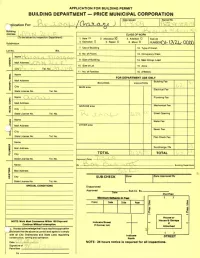
Building Permits
From the Public Works department: Please find attached two building permits for the property located at 605 North 200 East. Price City's building permit database holds permits from the late 90's to 2021.
Building Permits
From the Public Works department: Please find attached two building permits for the property located at 605 North 200 East. Price City's building permit database holds permits from the late 90's to 2021.Posted Date
Nov 07, 2024
Historical Record Date
Jul 08, 2009
Source Name
Price City Public Works
Document Source
Delete Story
Are you sure you want to delete this story?
Sep 07, 2001

-

- Marley Zielike
Aerial Photo
The image shows Price UT and the home in 2001. For a higher-resolution photo follow the link below. Title 2001 UT-01-BC Project Aerial Photograph: 75B-11-75 Caption 2001 UT-01-BC 75B-11-75 Air Photo Footprint Polygon (39.640362, -110.845237), (39.640362, -110.795822), (39.590947, -110.795822), (39.590947, -110.845237) Notes This aerial photo is contained in the U.S. Geological Survey (USGS) Earth Resources Observation and Science Center (EROS) EarthExplorer system. Upon clicking the Download button, you will be redirected to the EarthExplorer website to complete the download where an EarthExplorer user login is required.
Aerial Photo
The image shows Price UT and the home in 2001. For a higher-resolution photo follow the link below. Title 2001 UT-01-BC Project Aerial Photograph: 75B-11-75 Caption 2001 UT-01-BC 75B-11-75 Air Photo Footprint Polygon (39.640362, -110.845237), (39.640362, -110.795822), (39.590947, -110.795822), (39.590947, -110.845237) Notes This aerial photo is contained in the U.S. Geological Survey (USGS) Earth Resources Observation and Science Center (EROS) EarthExplorer system. Upon clicking the Download button, you will be redirected to the EarthExplorer website to complete the download where an EarthExplorer user login is required.
Sep 07, 2001
Aerial Photo
The image shows Price UT and the home in 2001. For a higher-resolution photo follow the link below.Title
2001 UT-01-BC Project Aerial Photograph: 75B-11-75
Caption
2001 UT-01-BC 75B-11-75 Air Photo
Footprint Polygon
(39.640362, -110.845237), (39.640362, -110.795822), (39.590947, -110.795822), (39.590947, -110.845237)
Notes
This aerial photo is contained in the U.S. Geological Survey (USGS) Earth Resources Observation and Science Center (EROS) EarthExplorer system. Upon clicking the Download button, you will be redirected to the EarthExplorer website to complete the download where an EarthExplorer user login is required.
Posted Date
Nov 07, 2024
Historical Record Date
Sep 07, 2001
Source Name
Utah Geological Survey
Delete Story
Are you sure you want to delete this story?
Nov 28, 1995
Nov 28, 1995
Delete Story
Are you sure you want to delete this story?
Jun 01, 1994

-

- Marley Zielike
History of Price
Utah History Encyclopedia, 1994 Price, the largest city in Carbon County and the county seat is situated in the Price River Valley of the Colorado Plateau in Utah. Named after LDS Bishop William Price of Goshen, who explored the area in 1869, Price was initially part of Sanpete County and later included in Emery County when it was formed in 1880. It became an organized community on July 14, 1892, while still part of Emery County. The first recorded settlers in the Price River Valley were Caleb Baldwin Rhoades and Abraham Powell, trappers from Salem, Utah. They arrived in October 1877 and built a cabin in what is now the northwest part of Price. After the trapping season, they returned to Salem, sparking interest among friends and family. However, Powell never returned, as he was tragically killed by a bear on December 7, 1878, in the Nebo Mountains. Rhoades returned to the valley on January 21, 1879, with Frederick Empire Grames and Charles W. Grames. The three men constructed homes for their families, who joined them later that year, along with other settlers, mostly from Utah County. Life for these early pioneers was challenging. Food was scarce, and irrigation water was difficult to obtain, requiring water to be hauled from the river in barrels. An irrigation ditch was a top priority, and Rhoades and Grames began digging two ditches in February 1879. The community eventually completed these ditches, but it was the construction of the Price Water Company Canal, finished in 1888, that provided a lasting solution to the irrigation problem. This canal remains in use today. The arrival of the railroad in 1883 significantly transformed Price from an isolated farming area into Castle Valley’s commercial hub. The town quickly became the region’s center for retail, politics, education, and culture. The railroad also facilitated access to nearby coal mines, drawing thousands of foreign-born, non-Mormon immigrants to work in the mining industry. Many miners initially lived in camps near the mines, but Price gradually absorbed these diverse groups, becoming a vibrant and culturally rich community. The town's population came to include a variety of ethnicities, primarily Greeks, Italians, Austrians, and Japanese, contributing to its enduring cultural diversity. Today, Price boasts numerous stores, businesses, parks, schools, recreational facilities, and a full-service hospital. It is also home to the College of Eastern Utah (CEU), a growing community college. The recent expansion of CEU’s Prehistoric Museum has turned it into one of the world's leading institutions of its kind. Price’s economy remains closely linked to the coal industry, which has led to periods of economic fluctuation. Nevertheless, Price continues to serve as Castle Valley’s commercial and cultural heart. In 1990, the population was 8,712, and the town has maintained its unique character among Utah communities. Photo 1: Main Street (looking East) Price, Utah Photo 2: Old Price City Train Depot
History of Price
Utah History Encyclopedia, 1994 Price, the largest city in Carbon County and the county seat is situated in the Price River Valley of the Colorado Plateau in Utah. Named after LDS Bishop William Price of Goshen, who explored the area in 1869, Price was initially part of Sanpete County and later included in Emery County when it was formed in 1880. It became an organized community on July 14, 1892, while still part of Emery County. The first recorded settlers in the Price River Valley were Caleb Baldwin Rhoades and Abraham Powell, trappers from Salem, Utah. They arrived in October 1877 and built a cabin in what is now the northwest part of Price. After the trapping season, they returned to Salem, sparking interest among friends and family. However, Powell never returned, as he was tragically killed by a bear on December 7, 1878, in the Nebo Mountains. Rhoades returned to the valley on January 21, 1879, with Frederick Empire Grames and Charles W. Grames. The three men constructed homes for their families, who joined them later that year, along with other settlers, mostly from Utah County. Life for these early pioneers was challenging. Food was scarce, and irrigation water was difficult to obtain, requiring water to be hauled from the river in barrels. An irrigation ditch was a top priority, and Rhoades and Grames began digging two ditches in February 1879. The community eventually completed these ditches, but it was the construction of the Price Water Company Canal, finished in 1888, that provided a lasting solution to the irrigation problem. This canal remains in use today. The arrival of the railroad in 1883 significantly transformed Price from an isolated farming area into Castle Valley’s commercial hub. The town quickly became the region’s center for retail, politics, education, and culture. The railroad also facilitated access to nearby coal mines, drawing thousands of foreign-born, non-Mormon immigrants to work in the mining industry. Many miners initially lived in camps near the mines, but Price gradually absorbed these diverse groups, becoming a vibrant and culturally rich community. The town's population came to include a variety of ethnicities, primarily Greeks, Italians, Austrians, and Japanese, contributing to its enduring cultural diversity. Today, Price boasts numerous stores, businesses, parks, schools, recreational facilities, and a full-service hospital. It is also home to the College of Eastern Utah (CEU), a growing community college. The recent expansion of CEU’s Prehistoric Museum has turned it into one of the world's leading institutions of its kind. Price’s economy remains closely linked to the coal industry, which has led to periods of economic fluctuation. Nevertheless, Price continues to serve as Castle Valley’s commercial and cultural heart. In 1990, the population was 8,712, and the town has maintained its unique character among Utah communities. Photo 1: Main Street (looking East) Price, Utah Photo 2: Old Price City Train Depot
Jun 01, 1994
History of Price
Utah History Encyclopedia, 1994Price, the largest city in Carbon County and the county seat is situated in the Price River Valley of the Colorado Plateau in Utah. Named after LDS Bishop William Price of Goshen, who explored the area in 1869, Price was initially part of Sanpete County and later included in Emery County when it was formed in 1880. It became an organized community on July 14, 1892, while still part of Emery County.
The first recorded settlers in the Price River Valley were Caleb Baldwin Rhoades and Abraham Powell, trappers from Salem, Utah. They arrived in October 1877 and built a cabin in what is now the northwest part of Price. After the trapping season, they returned to Salem, sparking interest among friends and family. However, Powell never returned, as he was tragically killed by a bear on December 7, 1878, in the Nebo Mountains.
Rhoades returned to the valley on January 21, 1879, with Frederick Empire Grames and Charles W. Grames. The three men constructed homes for their families, who joined them later that year, along with other settlers, mostly from Utah County.
Life for these early pioneers was challenging. Food was scarce, and irrigation water was difficult to obtain, requiring water to be hauled from the river in barrels. An irrigation ditch was a top priority, and Rhoades and Grames began digging two ditches in February 1879. The community eventually completed these ditches, but it was the construction of the Price Water Company Canal, finished in 1888, that provided a lasting solution to the irrigation problem. This canal remains in use today.
The arrival of the railroad in 1883 significantly transformed Price from an isolated farming area into Castle Valley’s commercial hub. The town quickly became the region’s center for retail, politics, education, and culture. The railroad also facilitated access to nearby coal mines, drawing thousands of foreign-born, non-Mormon immigrants to work in the mining industry. Many miners initially lived in camps near the mines, but Price gradually absorbed these diverse groups, becoming a vibrant and culturally rich community. The town's population came to include a variety of ethnicities, primarily Greeks, Italians, Austrians, and Japanese, contributing to its enduring cultural diversity.
Today, Price boasts numerous stores, businesses, parks, schools, recreational facilities, and a full-service hospital. It is also home to the College of Eastern Utah (CEU), a growing community college. The recent expansion of CEU’s Prehistoric Museum has turned it into one of the world's leading institutions of its kind.
Price’s economy remains closely linked to the coal industry, which has led to periods of economic fluctuation. Nevertheless, Price continues to serve as Castle Valley’s commercial and cultural heart. In 1990, the population was 8,712, and the town has maintained its unique character among Utah communities.
Photo 1: Main Street (looking East) Price, Utah
Photo 2: Old Price City Train Depot
Posted Date
Nov 07, 2024
Historical Record Date
Jun 01, 1994
Source Name
Utah History Encyclopedia, 1994
Delete Story
Are you sure you want to delete this story?
Mar 10, 1994
Mar 10, 1994
Delete Story
Are you sure you want to delete this story?
Oct 28, 1993
Oct 28, 1993
Delete Story
Are you sure you want to delete this story?
Jun 01, 1993
Jun 01, 1993
Delete Story
Are you sure you want to delete this story?
Jun 01, 1989

Rand Maxwell in the News
Previous resident Rand Maxwell was featured in The Sun-Advocate in 1989 and again in 1990, as articles shown in chronological order.
Jun 01, 1989
Delete Story
Are you sure you want to delete this story?
Oct 15, 1987
Oct 15, 1987
Delete Story
Are you sure you want to delete this story?
Aug 15, 1984
Aug 15, 1984
Delete Story
Are you sure you want to delete this story?
Oct 13, 1979
Oct 13, 1979
Delete Story
Are you sure you want to delete this story?
May 09, 1979
May 09, 1979
Delete Story
Are you sure you want to delete this story?
Feb 01, 1973
Feb 01, 1973
Delete Story
Are you sure you want to delete this story?
Jun 01, 1972

-

- Marley Zielike
1972 GS-VDBH Project Aerial Photograph: 1-122
Aerial photo of Price Utah in 1972. Following the link for a larger image. Title 1972 GS-VDBH Project Aerial Photograph: 1-122 Caption 1972 GS-VDBH 1-122 Air Photo Footprint Polygon (39.635125, -110.853278), (39.635841, -110.788175), (39.585503, -110.787274), (39.584787, -110.85233) Notes This aerial photo is contained in the U.S. Geological Survey (USGS) Earth Resources Observation and Science Center (EROS) EarthExplorer system. Upon clicking the Download button, you will be redirected to the EarthExplorer website to complete the download where an EarthExplorer user login is required.
1972 GS-VDBH Project Aerial Photograph: 1-122
Aerial photo of Price Utah in 1972. Following the link for a larger image. Title 1972 GS-VDBH Project Aerial Photograph: 1-122 Caption 1972 GS-VDBH 1-122 Air Photo Footprint Polygon (39.635125, -110.853278), (39.635841, -110.788175), (39.585503, -110.787274), (39.584787, -110.85233) Notes This aerial photo is contained in the U.S. Geological Survey (USGS) Earth Resources Observation and Science Center (EROS) EarthExplorer system. Upon clicking the Download button, you will be redirected to the EarthExplorer website to complete the download where an EarthExplorer user login is required.
Jun 01, 1972
1972 GS-VDBH Project Aerial Photograph: 1-122
Aerial photo of Price Utah in 1972. Following the link for a larger image.Title
1972 GS-VDBH Project Aerial Photograph: 1-122
Caption
1972 GS-VDBH 1-122 Air Photo
Footprint Polygon
(39.635125, -110.853278), (39.635841, -110.788175), (39.585503, -110.787274), (39.584787, -110.85233)
Notes
This aerial photo is contained in the U.S. Geological Survey (USGS) Earth Resources Observation and Science Center (EROS) EarthExplorer system. Upon clicking the Download button, you will be redirected to the EarthExplorer website to complete the download where an EarthExplorer user login is required.
Posted Date
Nov 07, 2024
Historical Record Date
Jun 01, 1972
Source Name
Utah Geological Survey
Delete Story
Are you sure you want to delete this story?
Apr 29, 1971
Apr 29, 1971
Delete Story
Are you sure you want to delete this story?
Jun 30, 1966
Jun 30, 1966
Delete Story
Are you sure you want to delete this story?
Feb 11, 1965
Feb 11, 1965
Delete Story
Are you sure you want to delete this story?
Jun 18, 1962

Air Photo from 1962
The image shows the home and Price Utah in 1962. Follow the link for a higher-resolution photo. Title 1962 DRV Project Aerial Photograph: 2BB-178 Caption 1962 DRV 2BB-178 Air Photo
Jun 18, 1962
Air Photo from 1962
The image shows the home and Price Utah in 1962. Follow the link for a higher-resolution photo.Title
1962 DRV Project Aerial Photograph: 2BB-178
Caption
1962 DRV 2BB-178 Air Photo
Posted Date
Nov 07, 2024
Historical Record Date
Jun 18, 1962
Source Name
Utah Geological Survey
Delete Story
Are you sure you want to delete this story?
Jun 21, 1960
Jun 21, 1960
Delete Story
Are you sure you want to delete this story?
Nov 03, 1955

Price Youth Finishes Platoon Training At Kentucky Center
The article mentions Private Atelee Migliori, Jr. of 605 North Second East in 1955.
Nov 03, 1955
Delete Story
Are you sure you want to delete this story?
Jun 01, 1950
Jun 01, 1950

-

- Marley Zielike
1950 U.S. Census
The 1950s U.S. Census gives a glimpse into the life of those at 605 North 200 East. In 1950, Atelee Migliori (47) and his wife Virginia (37) lived in the home with their 10 children, whose ages ranged from newborn to 18 years old. Atelee ran his own service station, while Virginia dedicated herself to homemaking. Their eldest daughter, Marjorie, worked as a sales clerk at Chapman Records.
1950 U.S. Census
The 1950s U.S. Census gives a glimpse into the life of those at 605 North 200 East. In 1950, Atelee Migliori (47) and his wife Virginia (37) lived in the home with their 10 children, whose ages ranged from newborn to 18 years old. Atelee ran his own service station, while Virginia dedicated herself to homemaking. Their eldest daughter, Marjorie, worked as a sales clerk at Chapman Records.
1950 U.S. Census
The 1950s U.S. Census gives a glimpse into the life of those at 605 North 200 East.In 1950, Atelee Migliori (47) and his wife Virginia (37) lived in the home with their 10 children, whose ages ranged from newborn to 18 years old. Atelee ran his own service station, while Virginia dedicated herself to homemaking. Their eldest daughter, Marjorie, worked as a sales clerk at Chapman Records.
Posted Date
Oct 15, 2024
Historical Record Date
Jun 01, 1950
Delete Story
Are you sure you want to delete this story?
Jun 01, 1950
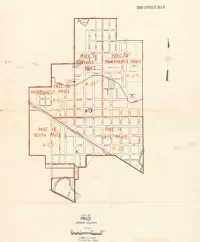
1950 Census Enumeration District Maps - Utah (UT) - Carbon County - Price - ED 4-21 to 25
In 1950, it should be noted that North 200 East was 2nd East Street, and East 600 North was North 6th Street.
Jun 01, 1950
1950 Census Enumeration District Maps - Utah (UT) - Carbon County - Price - ED 4-21 to 25
In 1950, it should be noted that North 200 East was 2nd East Street, and East 600 North was North 6th Street.Posted Date
Oct 15, 2024
Historical Record Date
Jun 01, 1950
Source Name
National Archives Catalog
Source Website
Delete Story
Are you sure you want to delete this story?
Sep 11, 1947
Sep 11, 1947

Former Resident, Mary Elizabeth Pintus Obituary
"Funeral Services This Morning" for Mrs. Pintus who lived at 605 North 200 East in Price UT ni 1947.
Delete Story
Are you sure you want to delete this story?
Feb 16, 1942
Feb 16, 1942
Delete Story
Are you sure you want to delete this story?
Jun 01, 1937
Jun 01, 1937
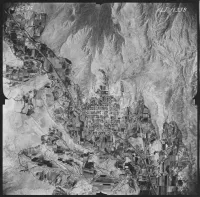
1937 ALJ Project Aerial Photograph: 11338
The following shows a satellite image of Price UT in 1937. Follow the link below for a high-resolution photo.
1937 ALJ Project Aerial Photograph: 11338
The following shows a satellite image of Price UT in 1937. Follow the link below for a high-resolution photo.Posted Date
Nov 07, 2024
Historical Record Date
Jun 01, 1937
Source Name
Utah Geological Survey
Delete Story
Are you sure you want to delete this story?
Jun 01, 1930

-

- Marley Zielike
1930 US Census
The following shows the residents of the home in 1930. In 1930, John J. Pintus (41) and his wife Elizabeth (39) lived with their two 17-year-old sons at 605 North 200 East. John worked as a machine runner in a coal mine, having been born in Pennsylvania, while Elizabeth, originally from Scotland, immigrated to the U.S. in 1910. Their sons were born in Wyoming. That year, the family owned a radio, and their home was valued at $7,000.
1930 US Census
The following shows the residents of the home in 1930. In 1930, John J. Pintus (41) and his wife Elizabeth (39) lived with their two 17-year-old sons at 605 North 200 East. John worked as a machine runner in a coal mine, having been born in Pennsylvania, while Elizabeth, originally from Scotland, immigrated to the U.S. in 1910. Their sons were born in Wyoming. That year, the family owned a radio, and their home was valued at $7,000.
Jun 01, 1930
1930 US Census
The following shows the residents of the home in 1930.In 1930, John J. Pintus (41) and his wife Elizabeth (39) lived with their two 17-year-old sons at 605 North 200 East. John worked as a machine runner in a coal mine, having been born in Pennsylvania, while Elizabeth, originally from Scotland, immigrated to the U.S. in 1910. Their sons were born in Wyoming. That year, the family owned a radio, and their home was valued at $7,000.
Posted Date
Oct 15, 2024
Historical Record Date
Jun 01, 1930
Source Name
US Census
Delete Story
Are you sure you want to delete this story?
Aug 19, 1927
Aug 19, 1927
Delete Story
Are you sure you want to delete this story?
Jan 01, 1926
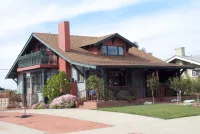
-

- Marley Zielike
The American Craftsman Architecture Style
The American Craftsman architectural style, or simply “Craftsman,” is a hallmark of American domestic architecture that emerged in the early 20th century, drawing deeply from the British Arts and Crafts movement. This style was influenced by the desire to return to simpler, handcrafted, and beautifully functional design, contrasting sharply with the ornate and machine-dominated aesthetics of the Victorian era. It quickly became popular in the United States, especially in small-to-medium-sized homes, reflecting a shift towards affordability, practicality, and an appreciation for artisanal craftsmanship. Origins and Influences The American Craftsman style was inspired by the British Arts and Crafts movement, which had taken root as early as the 1860s as a response to the Industrial Revolution’s effects on craftsmanship and worker conditions. Led by prominent thinkers like John Ruskin and William Morris, the British movement championed the dignity of human labor, valuing handwork over machine production, and sought to create beautiful yet simple objects and environments. This movement criticized the Victorian fascination with mass-produced, mismatched, and overly ornate items. The ethos of the Arts and Crafts movement aimed to restore art's role in daily life, combining functionality with beauty. The movement reached America toward the late 19th century, aligning with the decline of the Victorian era. American designers shared the British emphasis on simplicity, local materials, and social reform but adapted the style to the needs of a growing middle class. In the U.S., the movement was less exclusive and more scalable, allowing designs to be accessible to a broader market. This adaptability led to the creation of the “Craftsman” style, which was named after The Craftsman magazine, founded in 1901 by designer and furniture maker Gustav Stickley. Stickley’s magazine promoted home designs, furniture, and ideals that embodied the Craftsman spirit, elevating modest, functional, and affordable homes. Characteristics of the American Craftsman Style American Craftsman homes are defined by their clean, solid lines, a visibly sturdy structure, and the use of natural materials. The architectural elements of Craftsman homes often feature: - Low-pitched, gabled roofs with overhanging eaves, creating a sense of shelter and durability. - Exposed rafters and beams, showcasing the home’s structure and connecting it to the ideals of handwork. - Large front porches with thick, tapered columns or pedestals, inviting social interaction and promoting a connection to nature. - Built-in cabinetry, shelves, and benches, enhancing functionality while providing simple, elegant storage solutions. - Artistic touches like handcrafted wood, metal, and glasswork, including leaded or stained glass windows. In many ways, the Craftsman home was the architectural embodiment of “truth to materials” — celebrating the inherent beauty of wood, stone, and brick rather than disguising them. Regional Variations and the California Bungalow The Craftsman style found a particularly strong following in Southern California, where climate and lifestyle aligned well with its open, airy designs. Here, a smaller version of the Craftsman home became widely popular, known as the “California Bungalow.” These bungalows were smaller, single-story homes that retained the essential elements of the Craftsman style but in a more compact and affordable layout. The California Bungalow contributed to Craftsman’s spread nationwide, especially as it met the needs of middle-class families seeking modest yet aesthetically pleasing homes. Revival and Enduring Popularity The American Craftsman style peaked from around 1905 to the 1930s, after which the Great Depression limited new housing and design trends began to shift. However, the style’s emphasis on craftsmanship, simplicity, and connection to nature has led to several revival movements, particularly in the latter half of the 20th century and into the 21st century. Many original Craftsman homes have been restored, and new homes inspired by Craftsman principles continue to be built, showing the style's lasting appeal. Key Influences and Legacy American Craftsman architecture was heavily influenced by several design movements and cultures: Shingle Style: Transitioning from Victorian ornamentation, Shingle style influenced the Craftsman’s move toward simpler forms. Prairie Style: Prominent architects like Frank Lloyd Wright, influenced by Craftsman ideals, developed the Prairie Style, which shared similar values of harmony with nature and structural integrity. Mission Revival and Anglo-Japanese Style: Mission Revival brought in aspects of Southwestern architecture, while Anglo-Japanese aesthetics influenced the detailing and simplicity seen in Craftsman homes. The Craftsman style left an enduring mark on American architecture, celebrating functional beauty and a return to craftsmanship during an age of industrialization. This influence would later contribute to the Art Deco movement of the 1930s, where the principles of originality and artistry continued to evolve. Today, Craftsman homes are celebrated for their connection to history, with restored originals and new interpretations honoring their timeless qualities. These homes continue to resonate with homeowners who appreciate natural materials, handcrafted details, and a design philosophy rooted in simplicity and integrity.
The American Craftsman Architecture Style
The American Craftsman architectural style, or simply “Craftsman,” is a hallmark of American domestic architecture that emerged in the early 20th century, drawing deeply from the British Arts and Crafts movement. This style was influenced by the desire to return to simpler, handcrafted, and beautifully functional design, contrasting sharply with the ornate and machine-dominated aesthetics of the Victorian era. It quickly became popular in the United States, especially in small-to-medium-sized homes, reflecting a shift towards affordability, practicality, and an appreciation for artisanal craftsmanship. Origins and Influences The American Craftsman style was inspired by the British Arts and Crafts movement, which had taken root as early as the 1860s as a response to the Industrial Revolution’s effects on craftsmanship and worker conditions. Led by prominent thinkers like John Ruskin and William Morris, the British movement championed the dignity of human labor, valuing handwork over machine production, and sought to create beautiful yet simple objects and environments. This movement criticized the Victorian fascination with mass-produced, mismatched, and overly ornate items. The ethos of the Arts and Crafts movement aimed to restore art's role in daily life, combining functionality with beauty. The movement reached America toward the late 19th century, aligning with the decline of the Victorian era. American designers shared the British emphasis on simplicity, local materials, and social reform but adapted the style to the needs of a growing middle class. In the U.S., the movement was less exclusive and more scalable, allowing designs to be accessible to a broader market. This adaptability led to the creation of the “Craftsman” style, which was named after The Craftsman magazine, founded in 1901 by designer and furniture maker Gustav Stickley. Stickley’s magazine promoted home designs, furniture, and ideals that embodied the Craftsman spirit, elevating modest, functional, and affordable homes. Characteristics of the American Craftsman Style American Craftsman homes are defined by their clean, solid lines, a visibly sturdy structure, and the use of natural materials. The architectural elements of Craftsman homes often feature: - Low-pitched, gabled roofs with overhanging eaves, creating a sense of shelter and durability. - Exposed rafters and beams, showcasing the home’s structure and connecting it to the ideals of handwork. - Large front porches with thick, tapered columns or pedestals, inviting social interaction and promoting a connection to nature. - Built-in cabinetry, shelves, and benches, enhancing functionality while providing simple, elegant storage solutions. - Artistic touches like handcrafted wood, metal, and glasswork, including leaded or stained glass windows. In many ways, the Craftsman home was the architectural embodiment of “truth to materials” — celebrating the inherent beauty of wood, stone, and brick rather than disguising them. Regional Variations and the California Bungalow The Craftsman style found a particularly strong following in Southern California, where climate and lifestyle aligned well with its open, airy designs. Here, a smaller version of the Craftsman home became widely popular, known as the “California Bungalow.” These bungalows were smaller, single-story homes that retained the essential elements of the Craftsman style but in a more compact and affordable layout. The California Bungalow contributed to Craftsman’s spread nationwide, especially as it met the needs of middle-class families seeking modest yet aesthetically pleasing homes. Revival and Enduring Popularity The American Craftsman style peaked from around 1905 to the 1930s, after which the Great Depression limited new housing and design trends began to shift. However, the style’s emphasis on craftsmanship, simplicity, and connection to nature has led to several revival movements, particularly in the latter half of the 20th century and into the 21st century. Many original Craftsman homes have been restored, and new homes inspired by Craftsman principles continue to be built, showing the style's lasting appeal. Key Influences and Legacy American Craftsman architecture was heavily influenced by several design movements and cultures: Shingle Style: Transitioning from Victorian ornamentation, Shingle style influenced the Craftsman’s move toward simpler forms. Prairie Style: Prominent architects like Frank Lloyd Wright, influenced by Craftsman ideals, developed the Prairie Style, which shared similar values of harmony with nature and structural integrity. Mission Revival and Anglo-Japanese Style: Mission Revival brought in aspects of Southwestern architecture, while Anglo-Japanese aesthetics influenced the detailing and simplicity seen in Craftsman homes. The Craftsman style left an enduring mark on American architecture, celebrating functional beauty and a return to craftsmanship during an age of industrialization. This influence would later contribute to the Art Deco movement of the 1930s, where the principles of originality and artistry continued to evolve. Today, Craftsman homes are celebrated for their connection to history, with restored originals and new interpretations honoring their timeless qualities. These homes continue to resonate with homeowners who appreciate natural materials, handcrafted details, and a design philosophy rooted in simplicity and integrity.
Jan 01, 1926
The American Craftsman Architecture Style
The American Craftsman architectural style, or simply “Craftsman,” is a hallmark of American domestic architecture that emerged in the early 20th century, drawing deeply from the British Arts and Crafts movement. This style was influenced by the desire to return to simpler, handcrafted, and beautifully functional design, contrasting sharply with the ornate and machine-dominated aesthetics of the Victorian era. It quickly became popular in the United States, especially in small-to-medium-sized homes, reflecting a shift towards affordability, practicality, and an appreciation for artisanal craftsmanship.Origins and Influences
The American Craftsman style was inspired by the British Arts and Crafts movement, which had taken root as early as the 1860s as a response to the Industrial Revolution’s effects on craftsmanship and worker conditions. Led by prominent thinkers like John Ruskin and William Morris, the British movement championed the dignity of human labor, valuing handwork over machine production, and sought to create beautiful yet simple objects and environments. This movement criticized the Victorian fascination with mass-produced, mismatched, and overly ornate items. The ethos of the Arts and Crafts movement aimed to restore art's role in daily life, combining functionality with beauty.
The movement reached America toward the late 19th century, aligning with the decline of the Victorian era. American designers shared the British emphasis on simplicity, local materials, and social reform but adapted the style to the needs of a growing middle class. In the U.S., the movement was less exclusive and more scalable, allowing designs to be accessible to a broader market. This adaptability led to the creation of the “Craftsman” style, which was named after The Craftsman magazine, founded in 1901 by designer and furniture maker Gustav Stickley. Stickley’s magazine promoted home designs, furniture, and ideals that embodied the Craftsman spirit, elevating modest, functional, and affordable homes.
Characteristics of the American Craftsman Style
American Craftsman homes are defined by their clean, solid lines, a visibly sturdy structure, and the use of natural materials. The architectural elements of
Craftsman homes often feature:
- Low-pitched, gabled roofs with overhanging eaves, creating a sense of shelter and durability.
- Exposed rafters and beams, showcasing the home’s structure and connecting it to the ideals of handwork.
- Large front porches with thick, tapered columns or pedestals, inviting social interaction and promoting a connection to nature.
- Built-in cabinetry, shelves, and benches, enhancing functionality while providing simple, elegant storage solutions.
- Artistic touches like handcrafted wood, metal, and glasswork, including leaded or stained glass windows.
In many ways, the Craftsman home was the architectural embodiment of “truth to materials” — celebrating the inherent beauty of wood, stone, and brick rather than disguising them.
Regional Variations and the California Bungalow
The Craftsman style found a particularly strong following in Southern California, where climate and lifestyle aligned well with its open, airy designs. Here, a smaller version of the Craftsman home became widely popular, known as the “California Bungalow.” These bungalows were smaller, single-story homes that retained the essential elements of the Craftsman style but in a more compact and affordable layout. The California Bungalow contributed to Craftsman’s spread nationwide, especially as it met the needs of middle-class families seeking modest yet aesthetically pleasing homes.
Revival and Enduring Popularity
The American Craftsman style peaked from around 1905 to the 1930s, after which the Great Depression limited new housing and design trends began to shift. However, the style’s emphasis on craftsmanship, simplicity, and connection to nature has led to several revival movements, particularly in the latter half of the 20th century and into the 21st century. Many original Craftsman homes have been restored, and new homes inspired by Craftsman principles continue to be built, showing the style's lasting appeal.
Key Influences and Legacy
American Craftsman architecture was heavily influenced by several design movements and cultures:
Shingle Style: Transitioning from Victorian ornamentation, Shingle style influenced the Craftsman’s move toward simpler forms.
Prairie Style: Prominent architects like Frank Lloyd Wright, influenced by Craftsman ideals, developed the Prairie Style, which shared similar values of harmony with nature and structural integrity.
Mission Revival and Anglo-Japanese Style: Mission Revival brought in aspects of Southwestern architecture, while Anglo-Japanese aesthetics influenced the detailing and simplicity seen in Craftsman homes.
The Craftsman style left an enduring mark on American architecture, celebrating functional beauty and a return to craftsmanship during an age of industrialization. This influence would later contribute to the Art Deco movement of the 1930s, where the principles of originality and artistry continued to evolve.
Today, Craftsman homes are celebrated for their connection to history, with restored originals and new interpretations honoring their timeless qualities. These homes continue to resonate with homeowners who appreciate natural materials, handcrafted details, and a design philosophy rooted in simplicity and integrity.
Posted Date
Oct 29, 2024
Historical Record Date
Jan 01, 1926
Source Name
HouseNovel
Delete Story
Are you sure you want to delete this story?
Jun 01, 1925
Jun 01, 1925
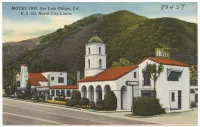
-

- Marley Zielike
National News from 1925
The following are some of the biggest news events from 1925: Scopes "Monkey" Trial (July 10-21, 1925): The Scopes Trial, also known as the "Monkey" Trial, took place in Dayton, Tennessee, where high school teacher John T. Scopes was prosecuted for teaching evolution in violation of state law. The trial, which pitted modernist and fundamentalist perspectives against each other, became a landmark case in the debate over science and religion in public education. First Motel Opens (December 12, 1925): The Milestone Motel, the first motel, opened in San Luis Obispo, California. This innovation in lodging catered to automobile travelers and marked the beginning of a new era in American travel and tourism, reflecting the growing popularity of road trips and car culture. Photo 2: shows the original postcard and then the motel in 2005. Publication of "The Great Gatsby" by F. Scott Fitzgerald (April 10, 1925): F. Scott Fitzgerald's novel "The Great Gatsby" was published, capturing the essence of the Roaring Twenties and exploring themes of wealth, ambition, and the American Dream. The book became a classic of American literature and a critical examination of the era's social dynamics. Photo shows the first edition of The Great Gatsby by F. Scott Fitzgerald. An original first edition runs about $4,500 in 2024. Opening of the Grand Ole Opry (November 28, 1925): The Grand Ole Opry, originally a radio show called "WSM Barn Dance," began broadcasting from Nashville, Tennessee. The Opry became a cornerstone of American country music, showcasing legendary artists and playing a key role in the genre's development. Establishment of the National Broadcasting Company (NBC) (November 15, 1925): The National Broadcasting Company (NBC) was founded, becoming the first major radio network in the United States. NBC revolutionized broadcasting by creating a nationwide network of affiliate stations, significantly expanding the reach and influence of radio. Founding of the Chrysler Corporation (June 6, 1925): Walter Chrysler founded the Chrysler Corporation, which quickly became a major player in the American automotive industry. Chrysler introduced innovative vehicles and production techniques, contributing to the growth of the auto industry. Inauguration of the New Yorker Magazine (February 21, 1925): The first issue of The New Yorker magazine was published, offering in-depth articles, fiction, satire, and cultural commentary. The magazine became an influential voice in American journalism and literature, known for its quality writing and unique perspective. California and Arizona Colorado River Water Compact (November 24, 1925): The Colorado River Compact was signed, allocating water rights among the states in the Colorado River Basin. The compact aimed to manage water resources and support agricultural and urban development in the southwestern United States. Completion of Mount Rushmore Sculpting (October 4, 1925): Sculptor Gutzon Borglum began work on Mount Rushmore, a monumental project carving the faces of four U.S. presidents into the Black Hills of South Dakota. The project symbolized American history and ideals, although it also sparked controversy over its impact on Native American lands. Establishment of the New York City Ballet (October 11, 1925): The New York City Ballet was founded by George Balanchine and Lincoln Kirstein. The company became one of the most prestigious ballet companies in the world, known for its innovative choreography and contributions to the performing arts.
National News from 1925
The following are some of the biggest news events from 1925: Scopes "Monkey" Trial (July 10-21, 1925): The Scopes Trial, also known as the "Monkey" Trial, took place in Dayton, Tennessee, where high school teacher John T. Scopes was prosecuted for teaching evolution in violation of state law. The trial, which pitted modernist and fundamentalist perspectives against each other, became a landmark case in the debate over science and religion in public education. First Motel Opens (December 12, 1925): The Milestone Motel, the first motel, opened in San Luis Obispo, California. This innovation in lodging catered to automobile travelers and marked the beginning of a new era in American travel and tourism, reflecting the growing popularity of road trips and car culture. Photo 2: shows the original postcard and then the motel in 2005. Publication of "The Great Gatsby" by F. Scott Fitzgerald (April 10, 1925): F. Scott Fitzgerald's novel "The Great Gatsby" was published, capturing the essence of the Roaring Twenties and exploring themes of wealth, ambition, and the American Dream. The book became a classic of American literature and a critical examination of the era's social dynamics. Photo shows the first edition of The Great Gatsby by F. Scott Fitzgerald. An original first edition runs about $4,500 in 2024. Opening of the Grand Ole Opry (November 28, 1925): The Grand Ole Opry, originally a radio show called "WSM Barn Dance," began broadcasting from Nashville, Tennessee. The Opry became a cornerstone of American country music, showcasing legendary artists and playing a key role in the genre's development. Establishment of the National Broadcasting Company (NBC) (November 15, 1925): The National Broadcasting Company (NBC) was founded, becoming the first major radio network in the United States. NBC revolutionized broadcasting by creating a nationwide network of affiliate stations, significantly expanding the reach and influence of radio. Founding of the Chrysler Corporation (June 6, 1925): Walter Chrysler founded the Chrysler Corporation, which quickly became a major player in the American automotive industry. Chrysler introduced innovative vehicles and production techniques, contributing to the growth of the auto industry. Inauguration of the New Yorker Magazine (February 21, 1925): The first issue of The New Yorker magazine was published, offering in-depth articles, fiction, satire, and cultural commentary. The magazine became an influential voice in American journalism and literature, known for its quality writing and unique perspective. California and Arizona Colorado River Water Compact (November 24, 1925): The Colorado River Compact was signed, allocating water rights among the states in the Colorado River Basin. The compact aimed to manage water resources and support agricultural and urban development in the southwestern United States. Completion of Mount Rushmore Sculpting (October 4, 1925): Sculptor Gutzon Borglum began work on Mount Rushmore, a monumental project carving the faces of four U.S. presidents into the Black Hills of South Dakota. The project symbolized American history and ideals, although it also sparked controversy over its impact on Native American lands. Establishment of the New York City Ballet (October 11, 1925): The New York City Ballet was founded by George Balanchine and Lincoln Kirstein. The company became one of the most prestigious ballet companies in the world, known for its innovative choreography and contributions to the performing arts.
National News from 1925
The following are some of the biggest news events from 1925:Scopes "Monkey" Trial (July 10-21, 1925): The Scopes Trial, also known as the "Monkey" Trial, took place in Dayton, Tennessee, where high school teacher John T. Scopes was prosecuted for teaching evolution in violation of state law. The trial, which pitted modernist and fundamentalist perspectives against each other, became a landmark case in the debate over science and religion in public education.
First Motel Opens (December 12, 1925): The Milestone Motel, the first motel, opened in San Luis Obispo, California. This innovation in lodging catered to automobile travelers and marked the beginning of a new era in American travel and tourism, reflecting the growing popularity of road trips and car culture. Photo 2: shows the original postcard and then the motel in 2005.
Publication of "The Great Gatsby" by F. Scott Fitzgerald (April 10, 1925): F. Scott Fitzgerald's novel "The Great Gatsby" was published, capturing the essence of the Roaring Twenties and exploring themes of wealth, ambition, and the American Dream. The book became a classic of American literature and a critical examination of the era's social dynamics. Photo shows the first edition of The Great Gatsby by F. Scott Fitzgerald. An original first edition runs about $4,500 in 2024.
Opening of the Grand Ole Opry (November 28, 1925): The Grand Ole Opry, originally a radio show called "WSM Barn Dance," began broadcasting from Nashville, Tennessee. The Opry became a cornerstone of American country music, showcasing legendary artists and playing a key role in the genre's development.
Establishment of the National Broadcasting Company (NBC) (November 15, 1925): The National Broadcasting Company (NBC) was founded, becoming the first major radio network in the United States. NBC revolutionized broadcasting by creating a nationwide network of affiliate stations, significantly expanding the reach and influence of radio.
Founding of the Chrysler Corporation (June 6, 1925): Walter Chrysler founded the Chrysler Corporation, which quickly became a major player in the American automotive industry. Chrysler introduced innovative vehicles and production techniques, contributing to the growth of the auto industry.
Inauguration of the New Yorker Magazine (February 21, 1925): The first issue of The New Yorker magazine was published, offering in-depth articles, fiction, satire, and cultural commentary. The magazine became an influential voice in American journalism and literature, known for its quality writing and unique perspective.
California and Arizona Colorado River Water Compact (November 24, 1925): The Colorado River Compact was signed, allocating water rights among the states in the Colorado River Basin. The compact aimed to manage water resources and support agricultural and urban development in the southwestern United States.
Completion of Mount Rushmore Sculpting (October 4, 1925): Sculptor Gutzon Borglum began work on Mount Rushmore, a monumental project carving the faces of four U.S. presidents into the Black Hills of South Dakota. The project symbolized American history and ideals, although it also sparked controversy over its impact on Native American lands.
Establishment of the New York City Ballet (October 11, 1925): The New York City Ballet was founded by George Balanchine and Lincoln Kirstein. The company became one of the most prestigious ballet companies in the world, known for its innovative choreography and contributions to the performing arts.
Posted Date
Nov 08, 2024
Historical Record Date
Jun 01, 1925
Source Name
HouseNovel
Delete Story
Are you sure you want to delete this story?
Jun 01, 1918
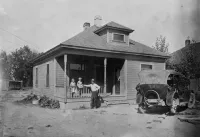
-

- Marley Zielike
Example Home in Price Utah
While it’s not the home at 605 North 200 East, this photo provides a window into what life was like at the time. It captures John Skerl with two of his daughters standing in front of their rented home in Price, where he was involved in the cattle business. Taken in the summer of 1918 in Price, Utah, the photo also features a 1917 Buick parked.
Example Home in Price Utah
While it’s not the home at 605 North 200 East, this photo provides a window into what life was like at the time. It captures John Skerl with two of his daughters standing in front of their rented home in Price, where he was involved in the cattle business. Taken in the summer of 1918 in Price, Utah, the photo also features a 1917 Buick parked.
Jun 01, 1918
Example Home in Price Utah
While it’s not the home at 605 North 200 East, this photo provides a window into what life was like at the time. It captures John Skerl with two of his daughters standing in front of their rented home in Price, where he was involved in the cattle business. Taken in the summer of 1918 in Price, Utah, the photo also features a 1917 Buick parked.Posted Date
Nov 08, 2024
Historical Record Date
Jun 01, 1918
Source Name
The University of Utah
Delete Story
Are you sure you want to delete this story?
Jun 01, 1910
Jun 01, 1910
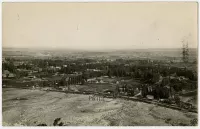
-

- Marley Zielike
History of Housing in Price
The history of housing development in Price, Utah, is closely tied to the region’s growth as a hub for mining and agriculture in the early 20th century. Price was founded in 1879 and incorporated as a city in 1911, largely shaped by the arrival of the Denver and Rio Grande Western Railroad in the 1880s. The railroad was instrumental in establishing Price as a key economic center, facilitating the growth of coal mining operations in nearby areas such as Helper and Castle Gate. The housing boom in Price started in the early 1900s, driven by the influx of miners and their families. During this period, the architecture was typically modest and functional, reflecting the needs of working-class families. Small, wood-framed houses and simple bungalows were common, often featuring porches and practical designs suitable for the local climate. As the city continued to grow, homes were often built near coal mines, railroads, and agricultural lands, creating distinct neighborhoods based on proximity to work opportunities. The 1920s and 1930s saw continued expansion, with homes reflecting a variety of architectural styles, from Craftsman bungalows to Tudor Revival houses. During the Great Depression, housing development slowed, but the New Deal brought infrastructure projects to the area, which helped stabilize the community and maintain local employment. After World War II, Price experienced another wave of housing development as returning veterans sought new homes. This era brought the construction of ranch-style houses and mid-century modern designs, expanding the city into suburban-style neighborhoods. As Price continued to serve as the economic center of Carbon County, housing reflected the changing needs and prosperity of the region. In the late 20th century, housing growth slowed as the coal industry declined, impacting the local economy. However, the city has preserved much of its historic character, with neighborhoods and homes still reflecting the diverse architectural influences of Price’s early years. Today, many of the original homes and buildings from the early 1900s still stand, providing a tangible link to the past and the city’s early economic boom. Black-and-white photograph depicting a view of Price, Utah, taken between 1910 and 1937 from the Clarence Stevenson collection.
History of Housing in Price
The history of housing development in Price, Utah, is closely tied to the region’s growth as a hub for mining and agriculture in the early 20th century. Price was founded in 1879 and incorporated as a city in 1911, largely shaped by the arrival of the Denver and Rio Grande Western Railroad in the 1880s. The railroad was instrumental in establishing Price as a key economic center, facilitating the growth of coal mining operations in nearby areas such as Helper and Castle Gate. The housing boom in Price started in the early 1900s, driven by the influx of miners and their families. During this period, the architecture was typically modest and functional, reflecting the needs of working-class families. Small, wood-framed houses and simple bungalows were common, often featuring porches and practical designs suitable for the local climate. As the city continued to grow, homes were often built near coal mines, railroads, and agricultural lands, creating distinct neighborhoods based on proximity to work opportunities. The 1920s and 1930s saw continued expansion, with homes reflecting a variety of architectural styles, from Craftsman bungalows to Tudor Revival houses. During the Great Depression, housing development slowed, but the New Deal brought infrastructure projects to the area, which helped stabilize the community and maintain local employment. After World War II, Price experienced another wave of housing development as returning veterans sought new homes. This era brought the construction of ranch-style houses and mid-century modern designs, expanding the city into suburban-style neighborhoods. As Price continued to serve as the economic center of Carbon County, housing reflected the changing needs and prosperity of the region. In the late 20th century, housing growth slowed as the coal industry declined, impacting the local economy. However, the city has preserved much of its historic character, with neighborhoods and homes still reflecting the diverse architectural influences of Price’s early years. Today, many of the original homes and buildings from the early 1900s still stand, providing a tangible link to the past and the city’s early economic boom. Black-and-white photograph depicting a view of Price, Utah, taken between 1910 and 1937 from the Clarence Stevenson collection.
History of Housing in Price
The history of housing development in Price, Utah, is closely tied to the region’s growth as a hub for mining and agriculture in the early 20th century. Price was founded in 1879 and incorporated as a city in 1911, largely shaped by the arrival of the Denver and Rio Grande Western Railroad in the 1880s. The railroad was instrumental in establishing Price as a key economic center, facilitating the growth of coal mining operations in nearby areas such as Helper and Castle Gate.The housing boom in Price started in the early 1900s, driven by the influx of miners and their families. During this period, the architecture was typically modest and functional, reflecting the needs of working-class families. Small, wood-framed houses and simple bungalows were common, often featuring porches and practical designs suitable for the local climate. As the city continued to grow, homes were often built near coal mines, railroads, and agricultural lands, creating distinct neighborhoods based on proximity to work opportunities.
The 1920s and 1930s saw continued expansion, with homes reflecting a variety of architectural styles, from Craftsman bungalows to Tudor Revival houses. During the Great Depression, housing development slowed, but the New Deal brought infrastructure projects to the area, which helped stabilize the community and maintain local employment.
After World War II, Price experienced another wave of housing development as returning veterans sought new homes. This era brought the construction of ranch-style houses and mid-century modern designs, expanding the city into suburban-style neighborhoods. As Price continued to serve as the economic center of Carbon County, housing reflected the changing needs and prosperity of the region.
In the late 20th century, housing growth slowed as the coal industry declined, impacting the local economy. However, the city has preserved much of its historic character, with neighborhoods and homes still reflecting the diverse architectural influences of Price’s early years.
Today, many of the original homes and buildings from the early 1900s still stand, providing a tangible link to the past and the city’s early economic boom.
Black-and-white photograph depicting a view of Price, Utah, taken between 1910 and 1937 from the Clarence Stevenson collection.
Posted Date
Nov 08, 2024
Historical Record Date
Jun 01, 1910
Source Name
The University of Utah
Delete Story
Are you sure you want to delete this story?
Jun 01, 1883

Mormon Settlers in Price
Black-and-white photograph of a Latter-day Saint family standing in front of a cabin in Price Canyon, Utah, in 1883.
Jun 01, 1883
Mormon Settlers in Price
Black-and-white photograph of a Latter-day Saint family standing in front of a cabin in Price Canyon, Utah, in 1883.Posted Date
Nov 08, 2024
Historical Record Date
Jun 01, 1883
Source Name
The University of Utah
Delete Story
Are you sure you want to delete this story?
Jun 01, 1868
Jun 01, 1868

-

- Marley Zielike
Native Lands Map
The following information highlights the tribe and language once spoken on the property’s land, as well as the treaty that was signed to establish settlement parcels. The pin shows the location of 605 North 200 East, Price, Utah. To be more specific, it could be related to the Treaty of Fort Bridger (1868), which impacted land in the region, or other local treaties or events in the late 19th century as settlers moved into Utah. About Native-Land.ca Native Land Digital, their mission is to spark meaningful conversations about the history of colonialism, Indigenous knowledge systems, and the relationships between settlers and Indigenous communities. They offer educational tools like maps and a Territory Acknowledgement Guide to encourage understanding and learning. Their goal is to move beyond outdated narratives and create a space where Indigenous communities can share stories and histories on their own terms. They also invite non-Indigenous people to explore and reflect on the history of the lands they inhabit, gaining insights into how they can play an active role in building a more respectful and united future.
Native Lands Map
The following information highlights the tribe and language once spoken on the property’s land, as well as the treaty that was signed to establish settlement parcels. The pin shows the location of 605 North 200 East, Price, Utah. To be more specific, it could be related to the Treaty of Fort Bridger (1868), which impacted land in the region, or other local treaties or events in the late 19th century as settlers moved into Utah. About Native-Land.ca Native Land Digital, their mission is to spark meaningful conversations about the history of colonialism, Indigenous knowledge systems, and the relationships between settlers and Indigenous communities. They offer educational tools like maps and a Territory Acknowledgement Guide to encourage understanding and learning. Their goal is to move beyond outdated narratives and create a space where Indigenous communities can share stories and histories on their own terms. They also invite non-Indigenous people to explore and reflect on the history of the lands they inhabit, gaining insights into how they can play an active role in building a more respectful and united future.
Native Lands Map
The following information highlights the tribe and language once spoken on the property’s land, as well as the treaty that was signed to establish settlement parcels. The pin shows the location of 605 North 200 East, Price, Utah.To be more specific, it could be related to the Treaty of Fort Bridger (1868), which impacted land in the region, or other local treaties or events in the late 19th century as settlers moved into Utah.
About Native-Land.ca
Native Land Digital, their mission is to spark meaningful conversations about the history of colonialism, Indigenous knowledge systems, and the relationships between settlers and Indigenous communities. They offer educational tools like maps and a Territory Acknowledgement Guide to encourage understanding and learning.
Their goal is to move beyond outdated narratives and create a space where Indigenous communities can share stories and histories on their own terms. They also invite non-Indigenous people to explore and reflect on the history of the lands they inhabit, gaining insights into how they can play an active role in building a more respectful and united future.
Posted Date
Nov 08, 2024
Historical Record Date
Jun 01, 1868
Source Name
Native-Land
Source Website
Delete Story
Are you sure you want to delete this story?


